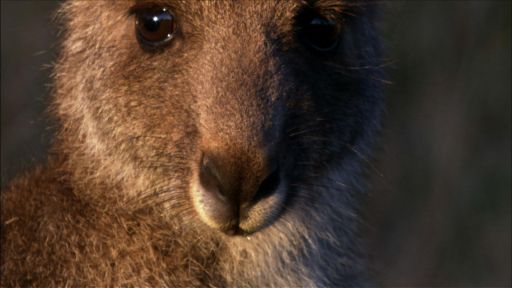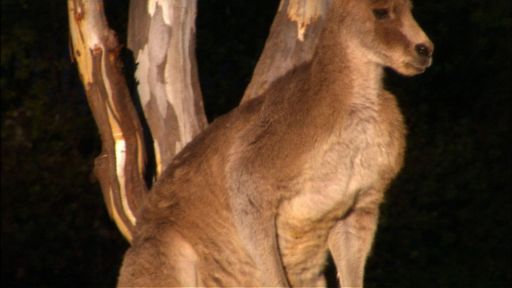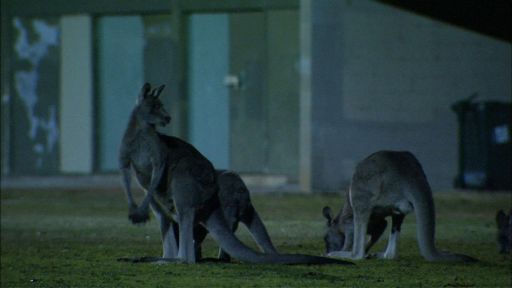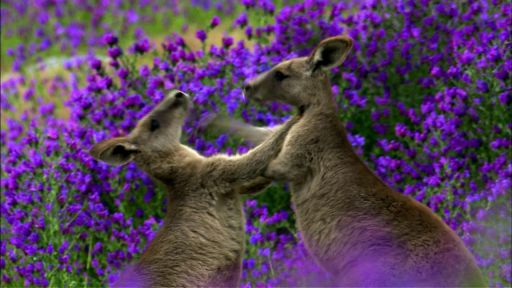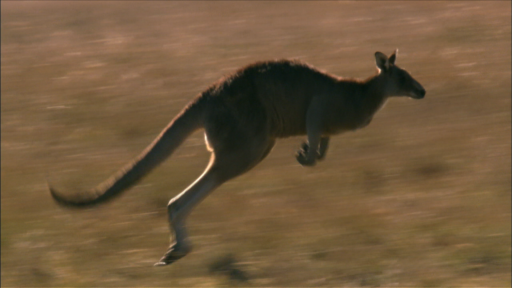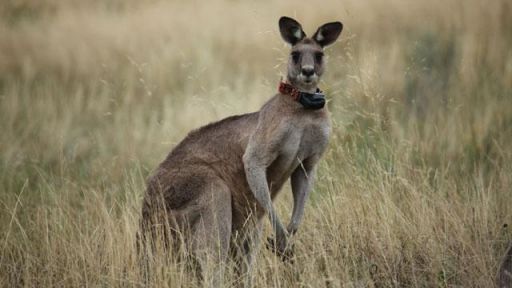Class: Mammalia
Infraclass: Marsupialia
Order: Diprotodontia
Family: Macropodidae
Genus: Macropus
The four species commonly referred to as kangaroos are: the red kangaroo (Macropus rufus), the eastern gray kangaroo (Macropus giganteus), the western gray kangaroo (Macropus fuliginosus), and the antilopine kangaroo (Macropus antilopinus).
Size and weight: A kangaroo can reach heights from anywhere between 3- 8 feet (1 to 3 meters) and can weigh between 40 and 200 lbs (18-100kg). The eastern gray kangaroo is the heaviest marsupial in the world and the red kangaroo is the largest.
Physical Features: The kangaroo has powerful hind legs and large feet, and a large muscular tail to keep it balanced while in motion. It is the only large animal to use hopping as its primary means of locomotion. A male kangaroo can leap to lengths of close to 30 feet and at a height of up to 10 feet. Its can reach speeds of up to 40 mph (60kmh).
Diet: The kangaroo is an herbivore, though its diet varies according to species. The animal has a chambered stomach, similar to that of cows, to help with the digestion process. The species also has highly specialized teeth. Its incisors are able to cut grass and shrubs extremely close to the ground and its molars are designed to grind down the vegetation. Its molars fall out regularly due to the wear and tear that comes with its diet, and are replaced with new teeth. The species has an unusual eating practice. The kangaroo regurgitates grass and shrubs that it has already eaten and chews it once more before swallowing it for final digestion. A kangaroo can survive for long periods without drinking water—hydrated by the moisture in the vegetation it consumes.
Geography: The kangaroo is endemic to Australia. The species is also found in Tasmania and nearby islands. Other marsupials can be found in some parts of Asia and the Americas, though the continent of Australia has by far the most, both in terms of species and population numbers.
Habitat: Woods and bushland, as well as grassland, savannas, forests, and scrubland. The species is highly adaptable and can live successfully in a wide range of habitats.
Breeding and Social Structure: The species often live in large groups known as mobs. These mobs can range in numbers anywhere from small groups to more than hundred kangaroos. The kangaroo is a highly social species, and often engages in nose touching or sniffing to build cohesion within the group. Boxing between males in the group is used to establish dominance. The dominant male leads the mob and has exclusive access to the females for mating.
A baby kangaroo is born only after about a month-long gestation period. Like all marsupials, the female kangaroo has a pouch, called a marsupium. Immediately after birth, the newborn—which is born hairless, blind, and under an inch in length—crawls into the pouch where it nurses and continues to develop. The joey, or baby kangaroo, remains in the pouch from anywhere between 120 and 400 days, depending on species. Even after leaving the pouch, it continues to feed off the mother for approximately a year and a half. Females produce two different types of milk, one for newborns and another for more mature joeys. During periods of drought, a female kangaroo loses the ability to conceive. As necessary resources are again available to the population, a female regains the ability to have offspring. In good conditions, a female gives birth annually.
Risks: Primarily humans who hunt the species for its meat and hide.
Additional Facts:
- The family name Macropodidae derives from macropods, meaning “big or large footed.”
- The word kangaroo comes from the aboriginal Guugu Yimithirr people’s word for the gray kangaroo (gangurru). The word was first recorded as “Kangooroo or Kanguru” in 1770 by British explorer James Cook.
- A long-standing myth says that the kangaroo’s name actually derives from a miscommunication between Cook and the aboriginal peoples. When Cook asked the locals the name of the species, they responded with the word “kangaroo”—supposedly translating to “I don’t know.” This, however, was not the case.
- A male kangaroo is called a buck, boomer, or jack and a female is referred to as a doe, flyer, or jill. A group of kangaroos (usually ten or more roos) is known as a mob, troop, or court.
- A kangaroo has excellent hearing. Like a cat, a kangaroo swivels its ears to pick up sounds.
- A kangaroo is unable to walk backwards.
- The kangaroo is represented on the Australian Coat of Arms, alongside the emu.
- Kangaroos are good swimmers.

